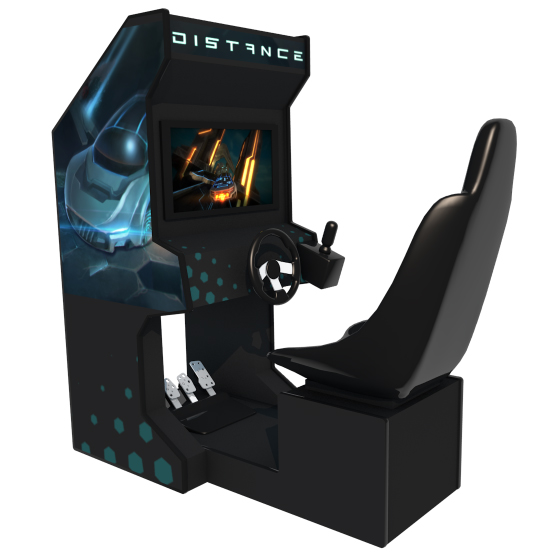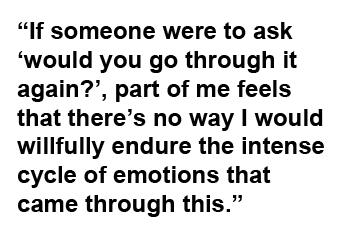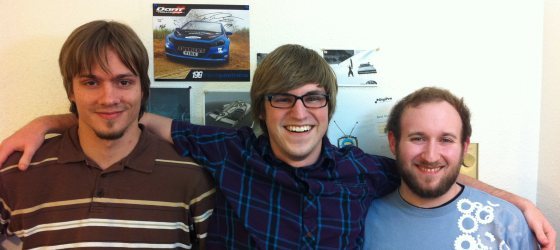By Jordan Hemenway
Since yesterday’s article was posted, Distance has passed the minimum goal needed to receive the funding from Kickstarter. In short, we’re shocked, relieved, burned out and excited, all at the same time. We don’t really have a complete grasp on what’s caused our rapid ascension over the past week, but I believe that the counting down clock is a powerful tool that Kickstarter exploits well. The stress of reaching our goal while having a doomsday clock hanging over our head seemed to be directly tied to the excitement (and fear) of our backers and supporters. Word spread faster than we had imagined possible, and the past 3 days of backers have easily been our best so far.
Looking back on how things could have been different if we could time-travel to the beginning of the campaign, I believe that we honestly went in with most of our assumptions being incorrect or untested. It’s far too easy to look at success stories on Kickstarter, look at how they pitched their project, how they set up rewards, how they did updates, etc., and assume that most of it will be applicable to ours. For example, discovering the details of our market was really fascinating. Despite our experience with the audience for Nitronic Rush, a free game we released as students, we didn’t fully have a gauge of how many would react to a commercial product. It would have been smart to do more research early on to see how many could back the project and what excites them about a spiritual successor. We found ourselves trying to understand this halfway through the campaign, which of course was the worst time for it.

Reaching out to press was another example of immense learning and adjustment. Our announcement press release wasn’t really grabbing people’s attention, so we had to continually tailor our message as more writers brought up what excites them about the game. One example was simply looking at how we initially phrased the game as the next generation of arcade racing. The game borrows from action-oriented elements of arcade racers, but overall it’s an experimental racing game much like its predecessor. Arcade racing to many refers to a dying breed, such as Wip3out and Midway racing games like Rush. While we love the spirit of those games, Distance is about experimenting with the dynamics of a very physical vehicle and seeing what we can do to push exploration in the racing genre.
Leaning less on the return of arcade racing and more on the new things we were trying to do, Distance started to stand out more. We released two new gameplay trailers which were also incredibly helpful in showing the elements of the game we were pushing, and it helped also get us something viral for people to easily share. Of course, our biggest mistake with these videos was that they took 5-6 days to make, complete with new music for each. We also had to schedule times to play with up to 6 others in multiplayer for the first trailer, which would take hours at a time for everyone. Instead we should have been planning these much farther ahead so that we would have enough time to plan their releases when coordinating with press.

In general content creation was slow for our team. If you’re planning to take on Kickstarter, I highly recommend assembling a strike team to work alongside you early on in the campaign. Managing comments, press, updates, content creation and other random things that come up continually buried us. It wasn’t until the end that we wised up enough to bring others into the fold.
We also worked with backers to continually modify and improve the Kickstarter campaign. For instance, our backers recommended reward tiers where they could get access to items like the backer-only vehicle at a lower price that only included one copy of the game. They suggested higher level digital-only tiers that granted Alpha access without needing to get a physical good, like our poster. Once we released these updates, a huge surge of backers would up their pledge, which was of course incredibly encouraging as we were reaching the end. We even listened to backers requesting guaranteed Linux support and split-screen, both of which we added and saw great success.
One gigantic push for the campaign (only a few days ago) was the purchase of one of our top rewards at $10,000, a complete arcade cabinet built exclusively for Distance. As seen in Jason’s 3D rendered mockup image, it has the classic arcade elements such as the steering wheel and pedals, but it also includes new features for car rotation, boost, and flight. We’re incredibly excited to build it and see it come to life. Once the thought of the reward crossed our minds, we spent hours researching the costs and efforts to build it. We saw it as the coolest reward yet that we’ve seen on Kickstarter, and we wanted to ensure that it wouldn’t bankrupt us. As it turns out the greatest cost for an arcade cabinet like this is the time to make it, and eventually the shipping. We’ll be borrowing access to a friend’s workshop to assemble the entire cabinet piece-by-piece.

Kickstarter has been a wild ride that I’m happy to have been a part of, if nothing else for the trial by fire learning experience. If someone were to ask ‘would you go through it again’ , part of me feels that there’s no way I would willfully endure the intense cycle of emotions that came through this campaign. Another part of me though realizes that our team has learned an incredible amount about Kickstarter at this point – the emotional struggle and general expectations – and at the end of the day the connection we have with our backers is incredibly powerful. We get to work with them to make the game of our dreams, with no middleman and nothing holding us back. For us, independence is huge, so it’s more than worth a try whether or not we to have hit the goal. Thanks to our backers, friends, family, and supporters who pushed us through so far, and we’ll see what happens in the final hours!

